
Random thoughts on the New Arena
While the site of the New Arena in Downtown Toledo appears to be a settled matter, it is still important to point out reasons why it should not go on the Superior Street site. Many of the points brought up here are in response to the Gateway Consulting Group report. This should not be construed as opposition an arena being built - quite the contrary. I am a hockey fan and look forward to an improved venue. My concern ensuring a project that is good for the long-term prospects of Toledo; prospects that are enhanced by good planning.
- The report continually touts the fact that Toledo is among the first cities to have the "trifecta" of a convention center, baseball park, and an arena all built adjacent to each other. The reason other cities do not do this is because it is recognized as bad planning. Too much of a single type use (entertainment) and the concentration of so many super blocks and the resulting decimation of the street grid make this "trifecta" a menace to the remainder of downtown uses such as office, retail, and especially residential.
- The Mud Hens draw large crowds to almost every game in their new location at 5/3rd Field. The notion that they gain significant attendance from people attending conventions is ridiculous. I doubt one in five hundred persons attending a Mud Hens game is attending a convention in town. The arena will do no better. The thought that having the the new arena next to Convention Center will generate meaningful attendance increases is wrong.
- Toledo taxpayers are being required to pay for a $30 million addition to the Convention Center as part of the arena project. The arena will only cost $50 - $55 million to build but the total cost of the "arean project" is $85 due to the Convention Center additions that nobody is talking about. This second project is by and large not supported by the public and is being piggy-backed on the arena in order to get it done.
- The assertion that the old Federal Building site should be left open for the view to the Maumee River is wrong. In an urban neighborhood/downtown area, views are not meant to be broad; views should be focused vistas. Expansive views are suburban if not rural.
Further, who is looking at the view of the River from Summit Street? In cold weather or rainy weather, walking along Summit Street in this stretch is inhospitable because pedestrians are completely unshelter from the elements. Drivers along this stretch should be watching the road and, really, their view is blocked by the trees at Water Street.
Views of the Maumee River are availble looking down the various east-west streets as a vista. These glimpses invite people down to Promenade Park itself which is really were we want to concentrate the activity associated with the waterfront anyway.
There are many buildings east of Summit Street already such as Key Bank, National City Bank Building, COSI, and the Steam Plant. The arena at the old Federal Building site would provide the "canyon" that people associate, that people expect, in a healthy urban environment. It also provides shelter, safety, and alternative activites for pedestrians who do want to walk along Summit Street.
The Arena - Alternate Locations
Most of what has been written on this site has been based on the assumption that these two institutions (three if you count the stadium) must be adjacent. But, what if the arena was not dependent on being next to the Convention Center. Below are two other locations in the downtown area that, based on urban planning criteria, would be better than the Superior Street site and even, possibly, the Summit Street site.
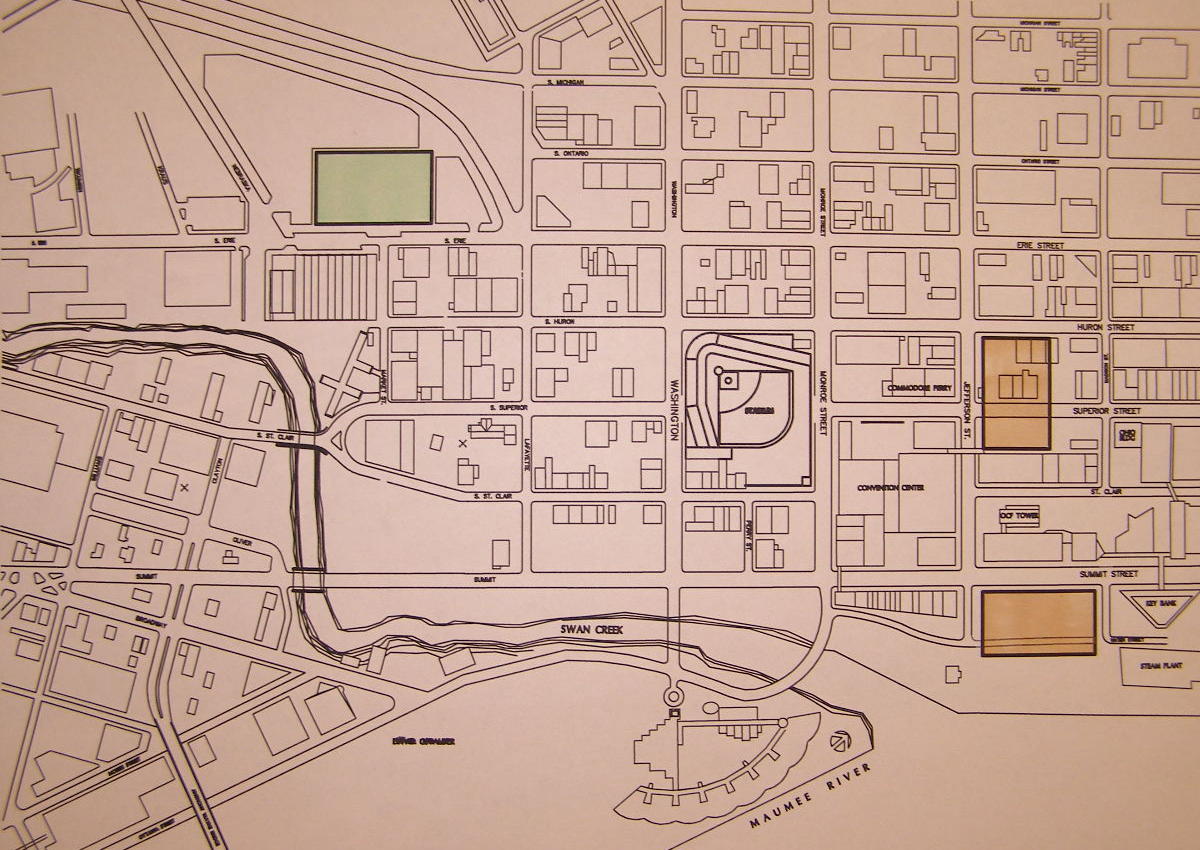
In this first alternative the arena (shaded green; the Superior and Summit Street sites are shaded tan) would be located between Nebraska, Erie Street, and the Anthony Wayne Trail angled entry into downtown, right across from the Erie Street Market. This location would make the arena a gateway into downtown Toledo and would be easily visible from I-75.
There are several builings that would have to be removed for this location but they are smaller and far more run down than those that would be removed for the Superior Street location (see the second graphic to see streets and buildings that would be lost at this site).
The Erie Street and Nebraska site would be beneficial in part because this would be an "edge" location. Edge locations are sites that in some way form a barrier, natural or man-made, that causes disruption in development patterns. In this case, the Anthony Wayne Trail and I-75 crossings create the edge. Other examples are train tracks, rivers and lakes, as well as universities.
An arena creates a disruption in the usual urban development pattern as well because it requires enough space that a "superblock" would typically be formed. By placing the arena at an already existing edge, the negative effects are lessened because people don't need to get beyond the arena; few people from the Warehouse District are going to be walking along or across the Anthoney Wayne Trail.
This location would also support projects in place or in the works such as the Erie Street Market and the various apartment/condo project in the area. Importantly, it further fills in a ring of prominent buildings (5/3rd Field, OCF, Maumee Bay Brewing Company, CUP, the Post Office, and the Erie Street Market) that will support the long-term success of the Warehouse District.
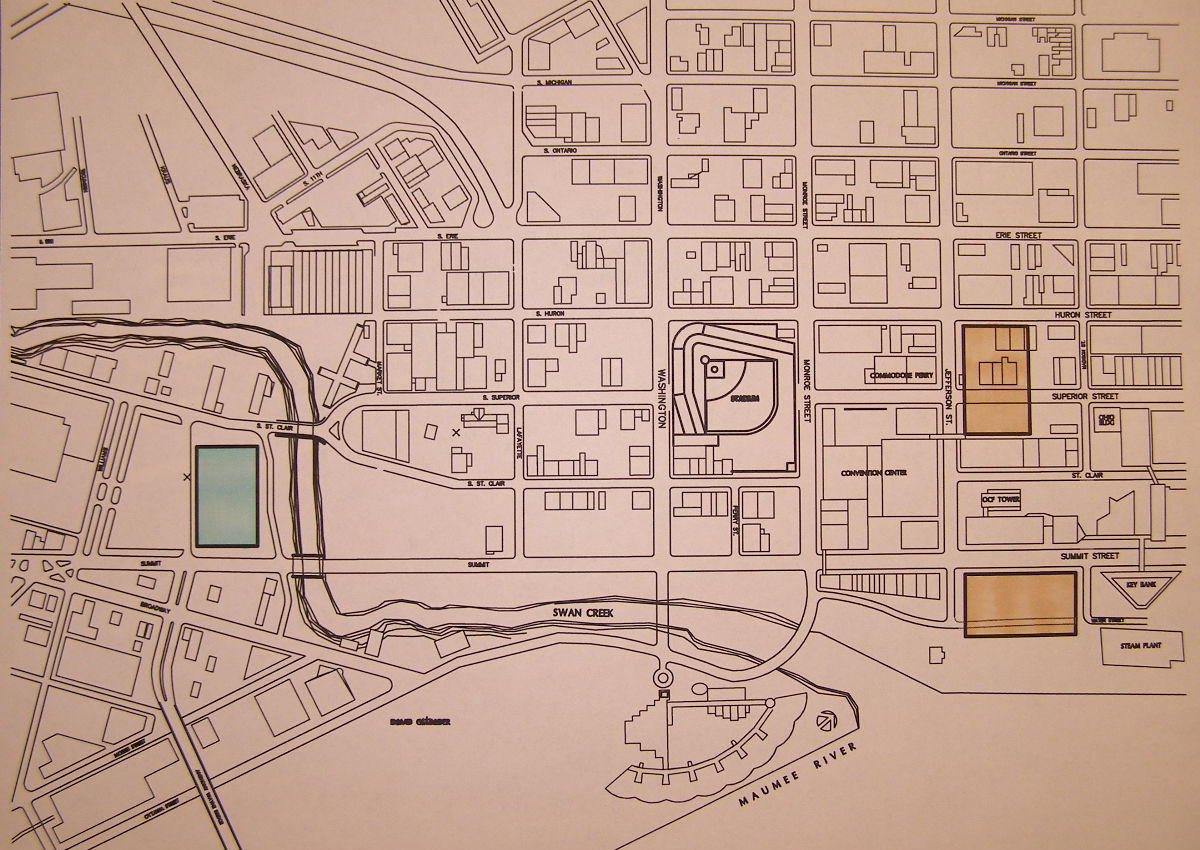
A second alternative would be at the base of the High Level Bridge, otherwise called the Anthoney Wayne Bridge. This site would be bound by Summit Street, a new road parrallel with Swann Creek, St. Clair Street and Williams. The Main Post Office is across Wiilams from this location.
This site has several advantage as well. It's ease of access from several directions would minimize potential negative traffic flows: the east side is easily accessed by the High Level (Anthony Wayne) Bridge; the south end residents would use either Broadway or the Anthony Wayne Trail; west Toledo residents would use the usual Monroe Street paths; and the north end is right up Summit Street.
This Summit Street site would also be an edge location along Swann Creek and also serve to re-energize existing projects in the near-downtown. It would create a midpoint destination between 5/3rd Field and the train station, Central Union Plaza not to mention be a benefit to the Erie Street Market and Oliver House projects.
This location would remove several small warehouses and a couple houses. No major buildings would be removed nor significant roads closed.
The opportunity to continue work on the Swann Creek exercise path, a project long abandoned by the City, exists by putting the arena at this location. A new path at this site would join portions of the path that already exist and complete the project, connecting the Erie Street Market to the Martin Luther King Bridge (Cherry Street).
The Arena - A Little Background...
For many, the nuts and bolts of urban planning can be pretty dry. But like many professions, the details and nuance are vital to obtaining good results. Like the law, architecture, economics, and politics, urban planning is an art and a science combined - there are aspects of each which are governed by hard numbers and provable facts. But these professions are also driven by ideas and rules that are based on experience, experimentation, and common sense.
Urban planning and design has been around for thousands of years and really just grew out of the patterns of settlement in countless villages. The various uses of land, residential, commercial, public, etc., arranged themselves in ways that produced the greatest convenience, usefulness, and safety. These patterns and traditions grew into rules and were passed on. These rules were, by and larged, used to create cities large and small throughout the United States from its founding on through the early 20th century.
Then a new experiment, "modernism", was foisted upon cities by a group of experimentalist social scientists, design professionals, and public policy makers beginning after World War I. The new experiment ignored most of the traditions of urban design and made arbitrary and incorrect decisions about people and living patterns. Those decisions have over the years eventually lead to where we are today: placeless strip shopping centers, isolated indistinguishable apartment complexes, and the loss of great urban neighborhoods.
"Superblocks"
Among the ideas that became a casualty of the new "modernist" trend of urban design was the idea of small city blocks. Small city blocks with frequent streets is really one of the foundations of urban planning. Small blocks multiply the available pathways for cars and pedestrians, increase the economic opportunities for businesses, and create activity, interest, and safety in urban neighborhoods.
The best urban neighborhoods, whether here in Toledo or in Ann Arbor, New York City or Washington, are older neighborhoods with streets lined by building facades with lots of doors, windows, and architectural details and they possess a scale and proportion that is appropriate. And of course, a key element to these successful urban neighborhoods is frequent streets.
Modernists, in what they saw as an attempt to make everything stream-lined and ultra efficient, embraced and implemented planning patterns that increased block size and fully subjegated urban neighborhoods to the automobile. With this came one-way streets and acres and acres of surface parking imposed over the existing grid of downtown neighborhoods.
Superblocks are an obstacle to vehicular and pedestrian traffic providing fewer options and opportunities for drivers. Infrequent streets and greater distances between lights results in cars traveling faster. In turn, drivers are less prone to stop at businesses along these blocks and that damages the commerical viability of these buildings. These bad attributes all feed off each other worsening the problem.
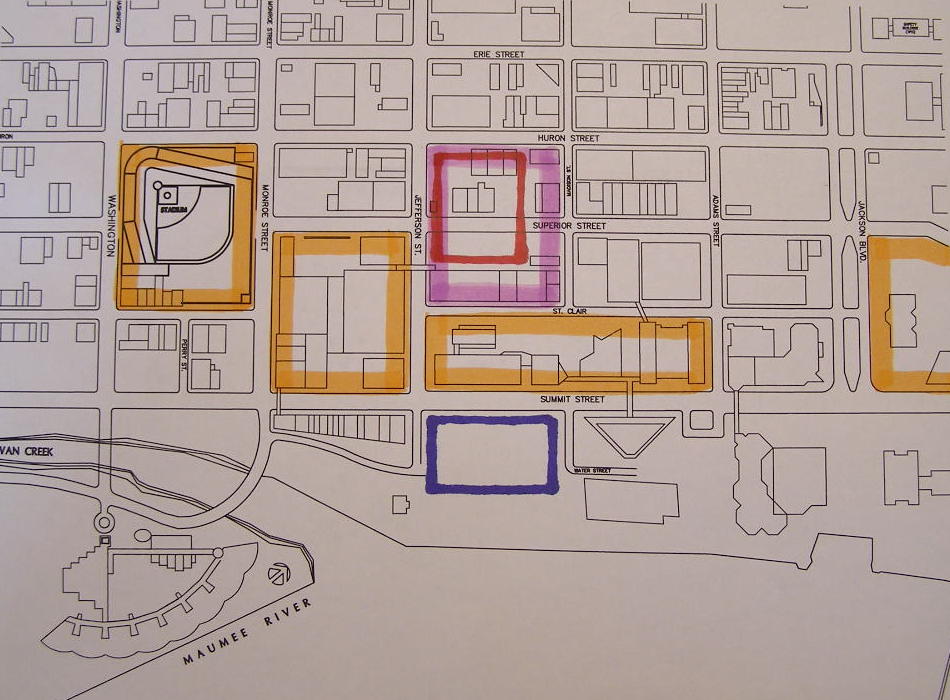
In this light, the placement of the arena over Superior Street (red box in graphic above) will further damage downtown Toledo by creating yet another superblock (purple box). The situation is already difficult downtown given the number of superblocks (orange boxes) that currently exist and the number of streets that have been cut off. The problem of vacant buildings and businesses leaving downtown over the last few decades is in part a result of bad planning decisions that brought about this large number of superblocks.
The Summit Street site (blue box) would allow the arena to be built in a downtown location adjacent to the Convention Center and convenient to 5/3rd Field while conforming to the existing street grid. The Summit Street location would NOT create an additional superblock, would NOT cut off additional streets, and could actually be the impetus for reconnecting parts of the grid that have been removed before.
While most people don't study urban planning, they do instinctively understand and like good mixed-use urban neighborhoods when they see them. It is encouraging that in the last few years, nearly everyone has come to recognize that one-way streets and surface parking lots are bad for downtown urban neighborhoods. It is time to recognize that "superblocks" are harmful as well.
The Arena - The Skyline
The skyline of the City of Toledo is actually quite nice. The mix of size and era buildings that frame the view of our fair city produces an image that is very photogenic. We have a good number of impressive and well designed buildings; Fort Industry Square, the former Owens Corning Fiberglas Tower, the Second National Bank (later Toledo Trust), the Steam Plant, Ohio Savings and Trust (now National City Bank), COSI, and the soon to be 5/3rd Bank at SeaGate.
One hideous exception to this is the parking garage at the corner of Summit Street and Jefferson (just to the right of Fort Industry and in front of the lower part of the Fiberglas Tower). The design of the garage incorporates street level offices and a promenade on the Summit Street side which was forward thinking at the time of its design. However, the metal perforated panels that are the facade for the actual garage area are an eye sore. The facade is dated and while it "speaks to" the era in which it was designed, it doesn't say kind things.
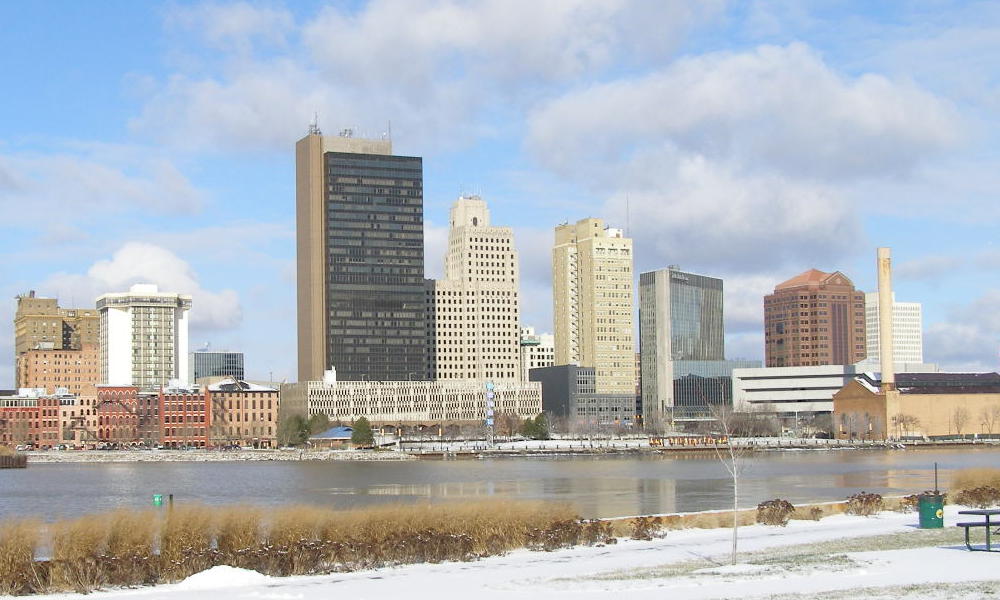
Placing the new arena at the Summit Street site would allow the City to add a sparkling jewel on the skyline of the City. Fortunately, that location for the arena would be right in front of the homely garage. An arena visble from the Maumee River or the Docks would contribute positively to the image of Toledo; it would be the picture used on promotional pieces, the view seen when Toledo makes the news locally or nationally, the view clients see when having dinner at one of the restaurants at the Docks.
Hunter Morrison, former Plan Commission Director in Cleveland, in his presentation in Toledo City Council Chambers, spoke of the importance of creating that image for Cleveland. It's something we should have in mind as well.
In addition, what view do we want people in the new arena and Convention Center addition to see when they look out from our new civic institution; sides of buildings, truncated streets, a parking garage? The views available from an arena built on Summit Street would be of Promenade Park, the Maumee River, the Docks and the new Marina District.
The Arena
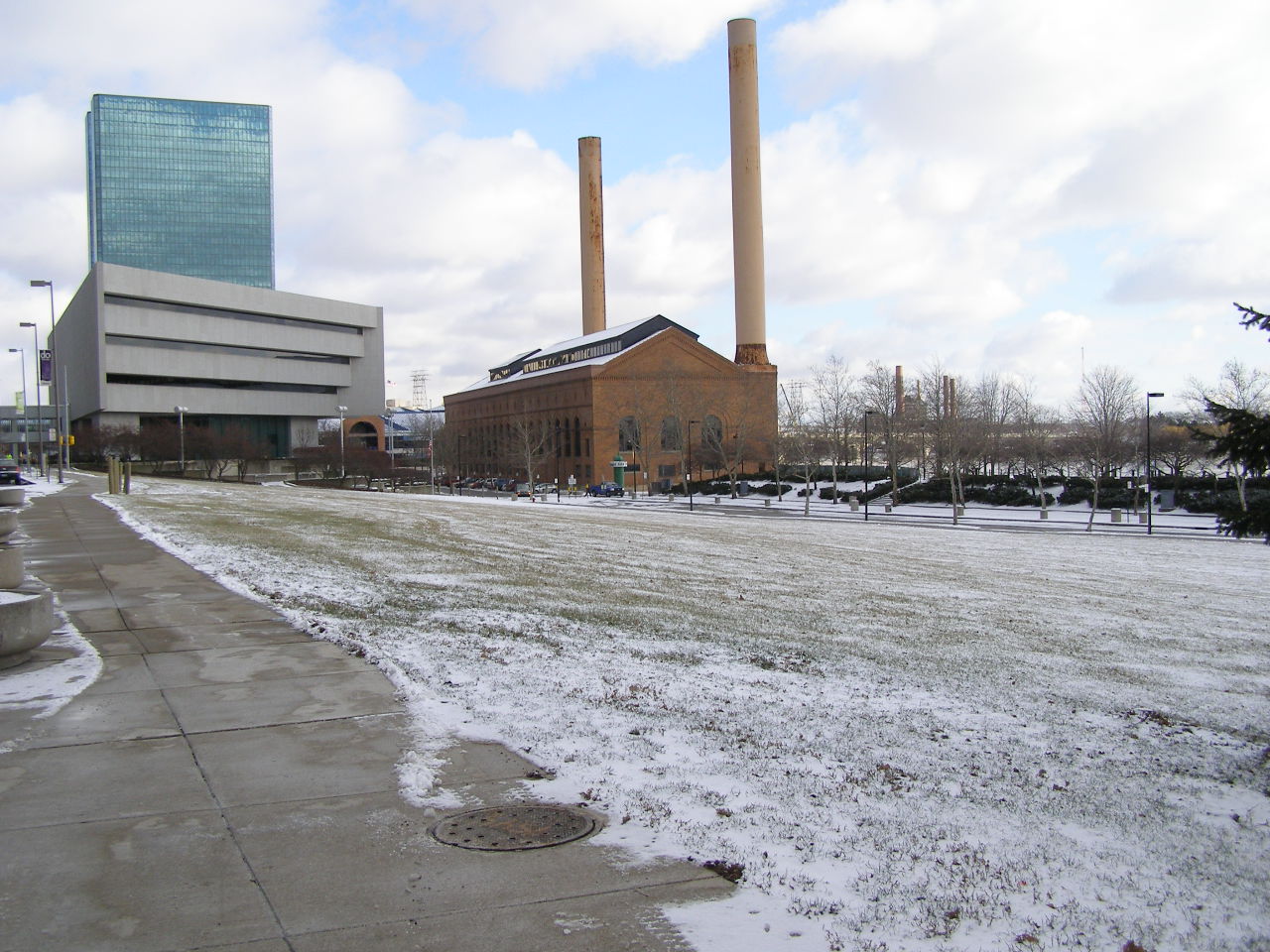
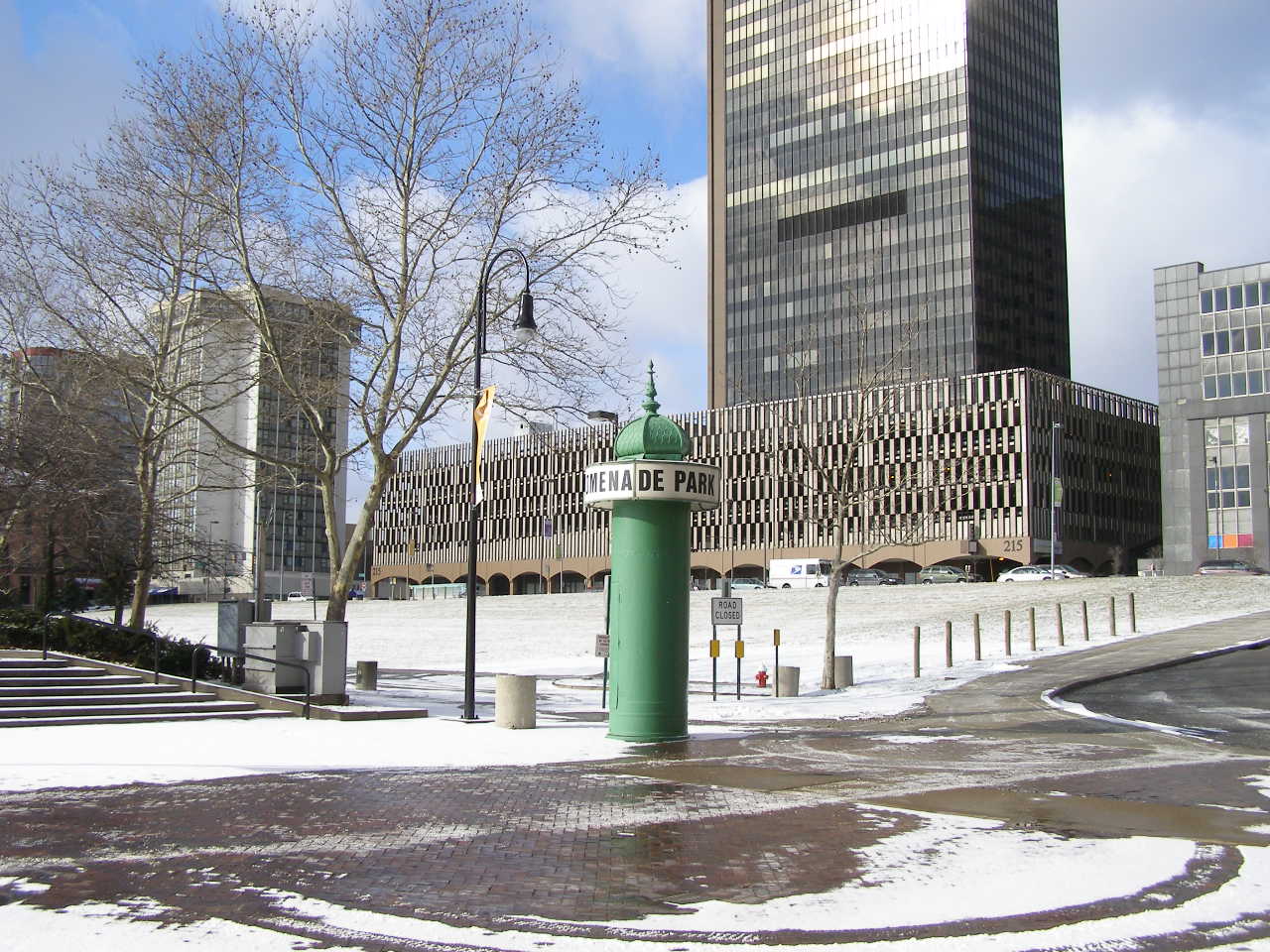
The development of the Steam Plant has floundered for a dozen years with occasional flurries of excitement and press conferences and back slapping showing off reems of beautiful color renderings of the newest incarnation of apartments and decks and parking schemes.
It will be a significant missed opportunity to get the Steam Plant project moving if the arena is not built on the Summit Street and Jefferson Avenue site. The chance to move the urban pulse of the City and downtown closer to the Maumee River, Promenade Park and, yes, the Steam Plant should not be missed.
The investment in the waterfront area in Toledo would be similar to the success of the Rock and Roll Hall of Fame, Browns Stadium, and the Science Center on the Cleveland waterfront and help secure the success of the arena as well as other investments made in the waterfront area.
I would suspect that investors would look more favorably upon the Steam Plant project if they saw the City and County putting significant public investments in an adjoining property. The ability to share in the benefits of improved infrastructure, utilities, and activity could make the Steam Plant project more than a dream and help Toledo make better use of perhaps our greatest resource, the Maumee River.
5/3rd Bank - A Lesson for the Arena
5/3rd Bank's relocating into the former OI building, One Seagate, is good news. One Seagate is a landmark building and needs to remain vital. The businesses in and around it will benefit from the increased traffic. This move will, however, create short-term difficulties and long-term opportunities for the Nicholas Building (where 5/3rd currently is located) and the businesses in that part of the downtown.
But also... hooray for the fact that the City of Toledo resisted tearing down buildings adjacent to the Nicholas Building so that 5/3rd Bank could have nearby parking and a new delivery lane.
There is an important lesson to be learned from this; our leaders, be them political, cultural, or financial, must think big-picture long-term. They must act with a plan in mind and with the mindset that they, we, and the City as a whole are going to succeed. They are custodians of our past and future; they are not the ends but the means. As such, all buildings in a Central Business District are important to preserve as part of the urban fabric; cultural resources and financial assets.
The short-term benefit for 5/3rd would NOT have been worth the long-term consequences to the City as a whole. All the evidence we need of the temperal nature of the business world is to look at our own past - gone are Milburn Wagon, Gendron Bicycle, Toledo Scale, Haughton Elevator and how many more. What remains is the need for a City that is planned for the success of the next generation of entrepenuers and businesses.
Maintaining a healthy building stock for both business and residential uses as well as roads and paths that service them are extremely important.
This same idea should be the lense through which we view the new arena and the Convention Center addition as well. The quick-fix benefits that are proported by advocates of the Superior Street location for these new projects should be viewed against the long-term negative effects for the remainder of the downtown; loss of buildings, businesses, and urban fabric that decrease opportunities, community, history, and accesibility.
The Arena - The Path and Views Lost
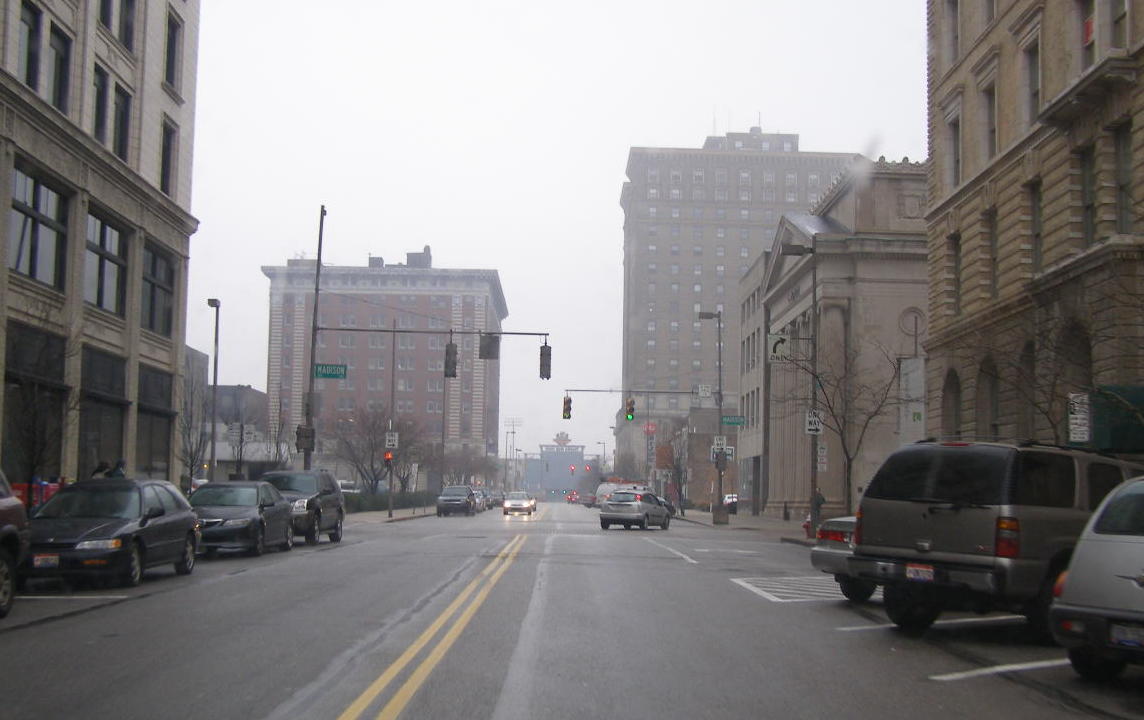
Superior at Madison Looking south. The view and path you would lose to 5/3rd Field from downtown with the proposed Superior Street arena site. By losing sight of the Warehouse District and being forced to turn away from the Warehouse District at this important intersection downtown, a driver is far more likely to be dissuaded to travel to the Warehouse District through the maze of cut off streets. Leaving work from one of the many parking lots on Superior Street near Jackson Street, drivers will no longer be easily able to get to Monroe Street on their way out of downtown. They are much more likely to instead turn west on Jackson or Adams or maybe Madison and skip any stops in the Warehouse District. They will instead stream past businesses in the Uptown area.
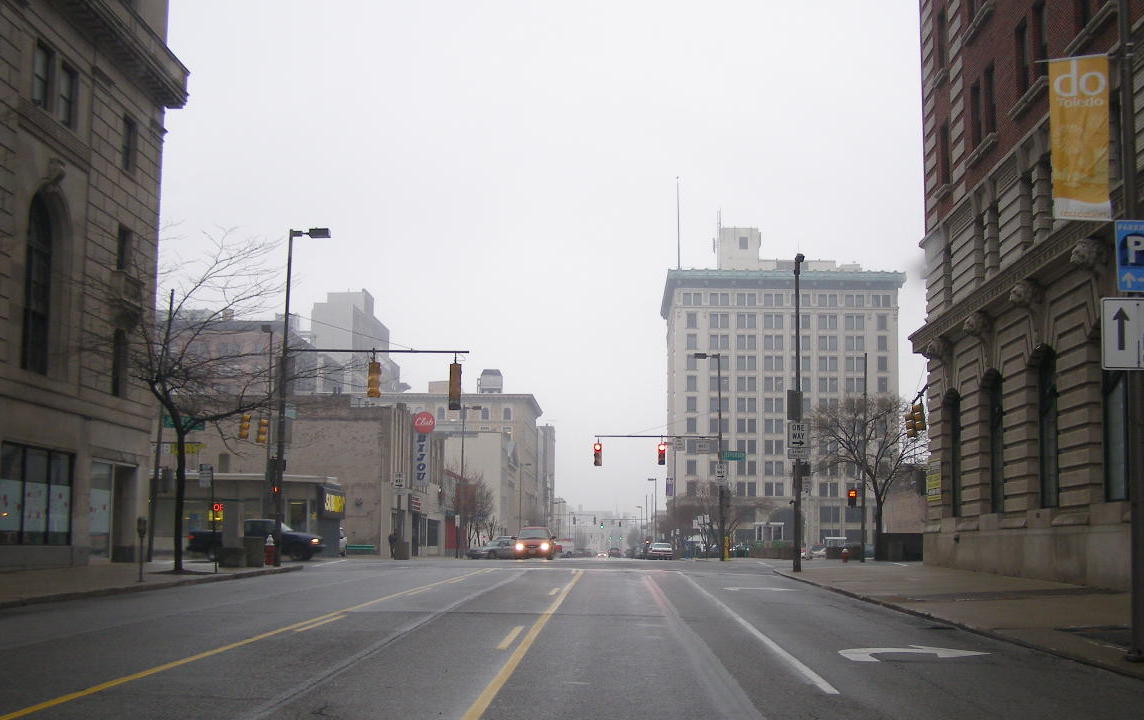
The view and path you would lose to the downtown from 5/3rd Field with the proposed arena site. Thousands of pedestrians and drivers who look forward to catching a glimpse of 5/3rd Field on their way into (or out of) town will be deprived of this simple pleasure - seeing the green pasture in the urban fabric. The loss of this popular path into downtown will force more and more traffic onto Erie Street. Erie Street is already plagued with too much traffic moving too fast and will be forced to assume more of the burden if the new arena closes down Superior Street. Decreasing the number of streets makes for a more stressful commute on the remaining streets which in turn increases speeds and makes customers less likely to stop and shop.
Arena Site
Hunter Morrison - What Works
After going to link, scroll about half way down page; click on mp3 for Hunter Morrison
Hunter Morrison is the former Director of the Cleveland Plan Commission and lead the team in the effort to revitalize downtown Cleveland. The team (which included Mr. Chema's Gateway Consulting) coordinated the work on the Gateway Project, the Flats, Playhouse Square, and the Lakefront including the Rock and Roll Hall of Fame, Scieve Museum, and the Browns Stadium.
Mr. Morrison is currently head of the Urban Studies program at Youngstown State University.
Mr. Morrison recently spoke in Toledo City Council chambers as part of the University of Toledo Urban Affairs Center's "What Works" speaker series. He addressed planning and development issues especially in reference to building public facilities. His words are very relevant to Toledo at this time as we consider building a new multi-sport arena in the Central Business District near the Convention Center.
You may want to download the mp3 and burn it onto disk for ease of listening.
Arena Site
Gateway Consulting's "Arena Action Plan"
Available through the Lucas County Commissioners' website, click on the "Arena Action Plan" link to access a pdf file of the plan.
The Superior Street site identified by the consultant for the construction of the new arena is not the best site. That is not to say that the arena itself would do poorly there. Indeed, a new arena is likely to do very well and would do well at any number of locations. The problem is how the Superior Street site adversely affects the remainder of the downtown and adjacent neighborhoods. The new arena will affect every aspect of downtown Toledo from economic development and business opportunities to the viability of residential neighborhoods to traffic patterns for vehicles and pedestrians. The Superior Street site violates many of the most basic ideas behind urban planning and would hinder additional development.
The consultant for the arena project, Gateway Consulting, has a history of success as a team member in large development projects, most notably the Gateway Project in Cleveland but also 5/3rd Field here in Toledo. However, Gateway Consulting has a specific expertise; development financing. They do not do engineering; they don't do market feasibility studies; and they are not planners.
On the Cleveland project, which included Jacobs Field, the basketball arena, and the theater district, Gateway Consulting was but one of many members of the development team that included a prominent nationally recognized urban planning firm. The planning firm was an essential member of the team in the success of revitalizing downtown Cleveland. (See "Hunter Morrison - What Works" on "Soap Box" page)
Gateway Consulting in their report to the Lucas County Commissioners on an arena in downtown Toledo did hire numerous additional consultants with very specific expertise to address specific aspects of the new arena. However, they failed to hire a planning consultant. A team member with expertise and experience in planning is important to ensure that the site would be the most advantageous for not just the arena, but for all businesses and citizens.
Some staff of the Toledo Plan Commission are opposed to the Superior Street site. This opposition comes after careful consideration and years of working on policy and urban planning in the downtown Toledo area. The large majority of local architects who attended a meeting called by the local chapter of the American Institute of Architects on the matter of the arena site concluded the Superior Street site was ill advised.
Gateway Consulting offered little evidence in their report as to why Superior Street should be the site. Their discussion of planning issues is completely inadequate. Further, the high costs of acquiring properties for Superior Street and the additional engineering and construction that will be required to build over the City of Toledo's primary sewer line which runs down the middle of Superior Street are not compared with similar costs for other possible sites.
The placement of the new arena in downtown Toledo is the correct decision and adjacency to the Convention Center and Mud Hens for shared efficiencies is good. But just any location will not do. The building must best serve the hundreds of thousands of area residents first and the several hundreds of tourists and conventioneers likely to use the arena second. The citizens of Toledo deserve a rigorous study of all aspects of the arena project in order to ensure the best possible outcome. This includes a thorough examination of planning issues done by a competent and independent planning firm with a history of innovation, expertise, and success.
Read the section of the report about site selection and see what you think.